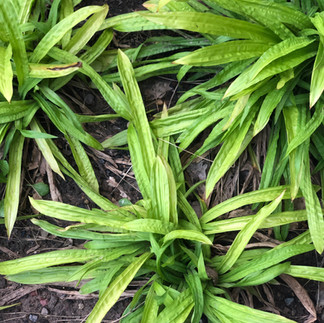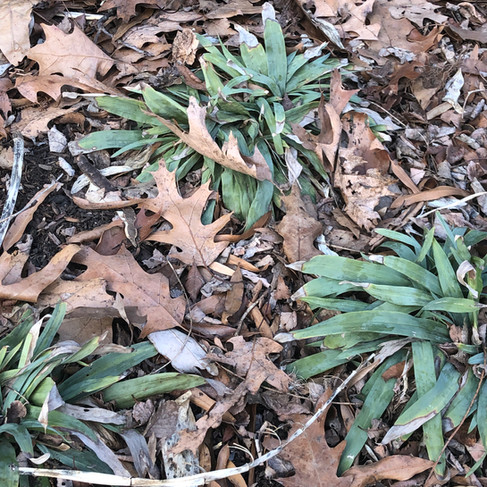Perfect time to take ten and get some winter zen.

This may not be new to you but I had a gardening "aha" moment a few days ago, and right smack dab in the middle of winter! I was watching a You Tube video about a garden in the UK when it dawned on me. They are not talking about adding "winter interest" to your garden; they are talking about the winter garden.
Some of us, like me, have been conditioned to think gardens are to be enjoyed in summer and, maybe, you can add some plants for "winter interest." Visit a "winter garden" and you may be inspired to think slightly differently! Take an 8 minute tour of a UK winter garden. While there is nary a Chesapeake native there, we have lots of native plants that will create a winter garden.
All of this prompted me to go outside since we have now had a couple of weeks of below freezing temperatures and snow and ice as well. The evergreens -- inkberry hollies (Ilex glabra), American hollies (Ilex opaca), eastern red cedars (Juniperus virginiana), northern cedars (Thuja occidentalis), and dwarf white pine (Pinus strobus 'nana') are all doing their evergreen thing and red twig dogwoods (Cornus sericea), winterberries (Ilex verticillata) and a river birch (Betula nigra) are adding hues of red and interesting bark and I was curious as to what else might be adding color.
I found a couple of perennials popping with color, even after freezing temps and snow. Please note, I garden in Zone 7a in an urban area so if you are gardening where it is colder, these plants may grow differently in your winter conditions. These winter photos were taken this week.
Blue Wood Sedge
Blue wood sedge (Carex flaccosperma) is a not an eye catching kind of plant but it really fills space in between other plants and shrubs nicely and adds blue color during the growing season. It grows in full shade to part sun in a range of soils. In winter, it is really standing out because most everything else is dormant. These were planted three years ago and will probably be large enough to divide to make more plants this year. This sedge is often sold at native plant nurseries and can also be purchased from on-line sources.
Plantain Leaf Sedge
Plantain leaf sedge (Carex plantaginea), also called seersucker sedge, is a wider leaf, low growing sedge that grows in shade to part shade. This is a great plant for adding texture. This sedge is fairly fast growing once established. It often will grow smaller new plants nearby and can also be divided to create more plants.
In the winter garden, plantain leaf sedge is strong. This sedge is often sold at native plant nurseries and can also be purchased from on-line sources.
Silver Sedge
Silver sedge (Carex platyphylla) is another wide leaf sedge with a distinct blue color that grows in shade or part shade. It works well if you are looking to mix different color and textures in and amongst a sea of green plants. Silver sedge seems relatively slow growing in my experience.
In the winter garden, silver sedge is holding its color. This sedge is often sold at native plant nurseries, occasionally at garden centers, and can also be purchased form on-line sources. Please note there is a Japanese sedge called "Silver Sceptre Sedge" frequently sold but that is not the native.
Heuchera 'Autumn Bride'

Heuchera "Autumn Bride' (Heuchera villosa 'Autumn Bride') is often planted because it blooms profusely in August when many other flowering perennials have succumbed to the August heat. It often continues blooming well into September.
In the winter garden, the foliage stays green and resists flattening for most of winter. The plants are not as full and robust as in summer but definitely holding their own. This cultivar of the native alumroot (Heuchera villosa) is sold at native plant nurseries that carry cultivars and many garden centers. It can also be purchased from on-line sources.

Golden Ragwort

Golden Ragwort (Packera Aurea) is a flowering perennial. In spring and early summer, it sends up 2 to 3 foot stems blooming with small golden yellow flowers. Golden ragwort grows in full shade to dappled shade. It can grow in moist or average soil. It also readily spreads through self seeding and can be easily divided to create more plants.
In the winter garden, the low foliage is still dark green. In this space, between the sidewalk and road, in full shade, it is holding up to winter quite well. These plants were divided and moved from another location this past fall. This perennial is often sold at native plant nurseries and can also be purchased form on-line sources.
If you haven't been out in your garden recently, you may want to take ten minutes or so to see where you might start, or add to, your winter garden. And then, I hope you encounter your moment of zen!











































Comments